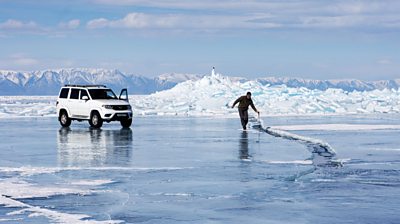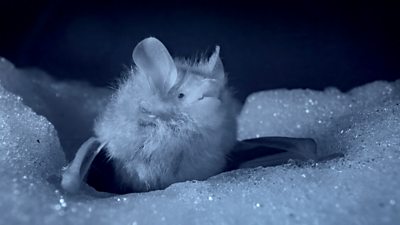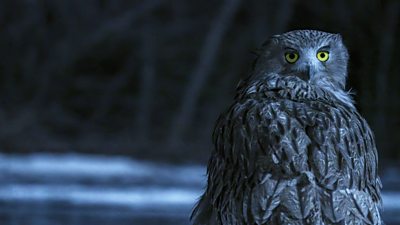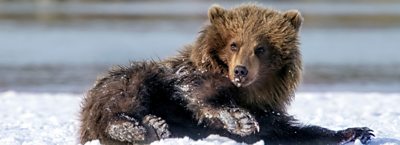Every year the northern half of Asia is transformed by snow and ice. Here an array of remarkable creatures defy some of the harshest conditions on Earth. Amidst relentless extremes, life not only endures, but flourishes in extraordinary ways.
In the heart of Russia lies Lake Baikal – the deepest, and oldest lake on the planet. It’s covered in ice, up to two metres thick, but in spring it begins to melt. In a snow den a Baikal seal pup is hidden from predators. As the den melts it has no option but to enter the chilly water below. Its mother must guide it to safety by swimming under the ice and appears to replenish the pup’s oxygen supply by exhaling bubbles for it to breath from. This behaviour has not been documented before.
On the northerly Japanese island of Hokkaido, thermal springs prevent rivers from freezing providing a crucial haven for Asia’s most iconic bird: the red-crowned crane. These cranes are symbols of love and longevity. They perform intricate dances to form bonds that can last a lifetime. But for a youngster, learning to dance isn’t straightforward – it takes time to perfect his moves.
In China the Tibetan Plateau becomes a vast frozen desert in winter, over four thousand metres up. Here a lone Himalayan wolf is hunting chiru antelope. The antelope can out-run the wolf, but the wolf has one advantage: unmatched perseverance. Over the course of several hours the wolf relentlessly pursues the chiru until it finally makes a kill.
In the forests where Russia, China, and North Korea meet, Amur tigers reign supreme. These forests are also home to Blakiston's fish owls, the largest of all owls, who display remarkable fishing skills to feed their young in the freezing night.
Food is hard to come by in the frozen north. On Hokkaido tiny long-tailed tit birds are given a boost by the rare appearance of sugar-rich icicles. These form overnight, out of tree sap, after deer have nibbled on bark. Lasting only a few hours, these ‘sapsicles’ are a rare source of energy and could mean the difference between life and death for these birds.
On Russia’s Kamchatka Peninsula brown bears prepare for hibernation by hunting salmon in a crater lake formed by ancient eruptions. With food scarce and competition from males a real threat, a mother bear struggles to ensure her cubs' survival - she must fatten them up otherwise they won’t live through their imminent hibernation. As winter draws in many other bears have already retreated to their dens, but the mother must push on, desperate to catch the salmon that will keep her cubs alive.
Like the bears, the Ussuri tube-nosed bat is a hibernator. Remarkably, this tiny mammal sleeps entombed in snowdrifts, surviving with a drastically slowed heartbeat. As spring arrives they awaken hungry but must warm up before they can hunt – they achieve this by shivering, and soon are up to flight temperature.
In northern Japan red foxes search for food on the sea ice – they’ve learnt to scavenge unwanted scraps from fishermen. But they’re not the only opportunists - large flocks of birds also gather and among them is the Steller’s sea eagle, the world’s heaviest raptor. The eagles’ talons are fearsome, but with careful timing, remarkable bravery, and not a little luck, the fox is able to steal a meal from the midst of a throng of eagles.
Across Asia’s frozen north sea ice is becoming increasingly scarce. Polar bears navigate across Arctic Russia in search of ice from which to hunt. In its absence they are trapped on often tiny islands. Large groups of them have inhabited an abandoned Soviet weather station waiting for the ice to return and offer them a hunting ground. When the sea does finally freeze the whole area becomes a polar bear playground.
- Watch all episodes of Asia on ����ý iPlayer and add to your Watchlist now
- Watch Asia, episode three on ����ý One from Sunday 17 November at 6.20pm
FS
Filming locations

- Baikal seal pup: Lake Baikal, Russia
- Red-crowned crane: Hokkaido, Japan
- Himalayan wolf and Tibetan antelope/Chiru: Tibetan Plateau, China
- Amur tiger and wild boar: Sikhote Alin, Khabarovsk Province, Russia
- Blakiston’s fish owl: Primorye Province, Russia
- Sap icicle and long-tailed tits: Hokkaido, Japan
- Kamchatka brown bear family: Kamchatka Peninsula, Russia
- Hibernating Ussurian tube-nosed bat: Hokkaido, Japan
- Red fox and Steller’s sea eagles: Hokkaido, Japan
- Polar bears in abandoned weather stations: North coast of Russia
Interesting Facts

- In Lake Baikal the team had to use thermally insulated diving suits with hot water inside. This allowed the divers to stay underwater for almost an hour and film some of the most intimate Baikal seal behaviour ever witnessed.
- To film the wild Siberian tigers the team deployed 20 separate camera trap units, left on-location for two years.
- The Blakiston’s fish owl is the largest owl in the world, so large that the native tribes sometimes mistake hunched owls in the twilight for big cats such as lynx
- The snow provides Ussurian tube-nosed bats great insulation whilst they hibernate in it. They’re one of very few mammals that actually hibernate in this way.
Filming Feats

- The footage seemingly showing a mother Baikal seal creating an air-pocket breathing aid for her pup, has excited seal scientists. It is potentially the first time this behaviour has been filmed or even observed in Baikal seals. The discovery provides a unique insight into the possible survival strategies of this species.
- The team’s perseverance resulted in capturing the first-ever broadcast footage of the Ussurian tube-nosed bat’s hibernation and awakening, showcasing the bats' extraordinary survival strategy.
Behind the Scenes

- To capture intimate footage of the Blakiston’s Fish Owl hunting the crew used remote cameras with ultra-high ISO capabilities to film in near-complete darkness. This technology was essential because traditional lighting could have temporarily blinded the owls and impaired their hunting. They also used remote camera heads positioned strategically at potential hunting spots. This setup, combined with the limited moonlight, allowed the crew to capture the Blakiston’s fish owl's winter hunting and nesting behaviours with unprecedented clarity.
